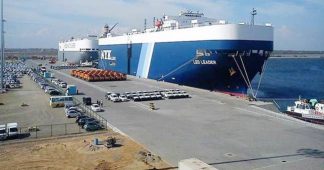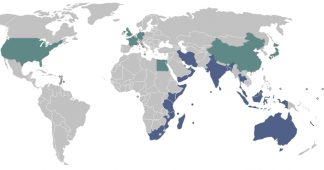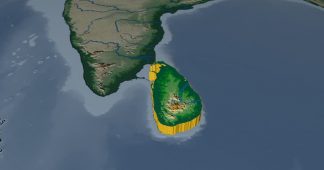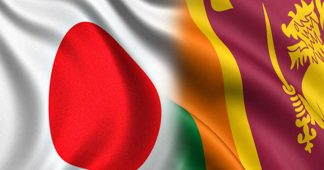By Lasanda Kurukulasuriya
While Sri Lankan politicians were distracted by apower struggle between the president and prime minister in December, the world’s superpower pulled off a heist in terms of extending its military footprint in Sri Lanka and, by extension, in the Indian Ocean.
Between 24– 29 January, the US Navy’s 7th Fleet for a second time carried out what it called a ‘temporary cargo transfer initiative’in Sri Lanka using the Bandaranaike International Airport (BIA),to move supplies on to the US aircraft carrierUSS John C Stennis, located off Sri Lankan waters. During the previous December operation involving the same aircraft carrier, the US had set up what it called a ‘logistics hub’ in Sri Lanka “to receive support, supplies and services” for US Navy ships operating in the Indian Ocean.The BIA was used for US military planes to bring in supplies, and for aircraft aboard the John C Stennis to fly in, load,and ferry them back.
The government has been tightlipped about how, when and why it entered intosuch a defence agreement. The attitude raisesquestions over its apparent lack of concern about sovereignty – reminiscent of the unprecedented manner in which it co-sponsored a resolution against Sri Lanka at the UN Human Rights Council in 2015.
The planes that gained entry to Bandaranaike International Airport (BIA), which is a commercial airport, were military craft. They do not come under Sri Lanka’s Civil Aviation Authority (CAA).It remains unclear whose jurisdiction these military craft would come under, while in Sri Lankan airspace and on Sri Lankan soil.Who would adjudicate if an accident or crime involving US aircraft or personnel takes place causing death or injury to Sri Lankans, or damage to property? Opposition MPs have alleged that Sri Lanka Customs, Police and Military have no control–e.g. power to inspect cargo. There is no information on whetherduties or charges are levied for services.
A US embassy statement says “Supplies may include personal mail for sailors, paper goods, spare parts and tools, and other items,” which sounds innocuous enough. But the next sentence says:“No cargo, military equipment, or personnel associated with this initiative will remain in Sri Lanka after the completion of the cargo transfer.” Why would military equipment or personnel be mentioned here, unless there is a possibility that they could be part of such transfers?
Asked if the CAA had any role in the operation, Director General of Civil Aviation and CEO H M C Nimalsiri said “The Defence Ministry informed us that they had granted approval for the operation.” He said “Basically these things happen with government approval.” The CAA has nothing to do with military craft and has no control in this regard. Military related matters were totally under government control and public accountability too was government’s responsibility, he said.
Is the President, who is Minister of Defence, aware of details of this agreement?
There is disingenuousness inUS efforts to present its activity as “a series of commercial transactions” (embassy spokesperson Nancy Van Horn),saying that it “promotes Sri Lanka’s efforts to become a regional hub for logistics and commerce” (embassy news release).
AnotherUS statement hasreportedly described the facility more candidly as a “military logistics hub,” revealing how Sri Lanka is being used. Washington-based Daya Gamage in anAsian Tribunereport of 31.01.19 quotes this other Jan. 23rd statement issued by the US mission in Colombo saying: “The United States Navy is doing a cargo transfer operation at Sri Lanka’s main international airport under a plan to use the island’s location to make it a MILITARY LOGISTICS HUB” (emphasis added).
Thegovernment appears to be going along with the embassy’s doublespeak, misleading the public. A Newfirst.lk report said: “News 1st inquired from the Secretary of Defence Hemasiri Fernando about the services supplied to USS John C Stennis through Sri Lanka. He said that the Ministry of Defense and the Ministry of Foreign Affairs has no involvement in this as these operations are carried out commercially.” Fernando could not be reached to clarify the statement attributed to him, as he was reported to be unwell.
The embassy’s claim that the “The January transfers will contribute approximately 25 million Sri Lankan Rupees to the country’s economy” is laughable, considering the paltriness of the sum in exchange for which the US has gained a huge military-strategic advantage in ahighly contested region.
The US statements have been careful to avoid mentioning where, off SL waters, the aircraft carrier was anchored, and where the military logistics hub is physically located. But local media reports point to Trincomalee – a strategic assethistorically coveted by foreign powers on account its fine natural deep-water port.
Both the US embassy and Prime Minister Ranil Wickremesinghe have been quick to deny Opposition claims that the ‘US plans to set up a military base in Sri Lanka.’ While that may be technically correct, it should be mentioned that nowadays the US strategy is not to establish full-blown, costly military bases overseas but to use the ‘Lily-pad’ concept, whereby it increases its force deployment globally, but with a smaller footprint. This affords a more nimble capability to move equipment and personnel where they are required in a contingency. In a statement on the Sri Lanka cargo transfer operation the 7th Fleet’s Logistics Readiness Cell chief Lt. Austin Gage hinted at such an approach when he said: “We are generating standard operating procedures to optimize our supply chain to be more agile and mobile and utilize strategic locations in the Indian Ocean.”
The Lily-pad approach involves bilateral arrangements with strategically located states, sometimes called ‘Status of Forces Agreements.’ The Maldives refused to sign such an agreement with the US. The rights sought to be secured through such agreements usually include, access to facilities free of charge, right to own and operate telecommunication systems and use radio spectrum, waiver of claims for damages and losses including death to personnel both military and civilian, disputes to be settled by consultation between parties and not through referral to any national or international court.
It is known that the US defence establishment has identified China as its main adversary, and sees the Asian giant’s expanding footprint in Sri Lanka – located near vital sea lanes – as a threat to its hegemony. Chinese investment in Hambantota porthas been a particular cause of anxiety.Both China and Sri Lankasaythat China’s activity in Hambantota is strictly commercial – a claim that Japan’s Defence Minister Itsunori Onodera sought to verify himself by visiting the port during hisAugust visit to Sri Lanka. The new arrangement between the US and Sri Lanka on the other hand is overtly military in its stated objective of servicing US naval craft in the Indian Ocean.
Do Sri Lankan political leaders fail to see how this small country is imperiled by their dangerous game of playing-off big powers against one another? Do they fail to grasp the sophistication of US military operations worldwide and lack understanding of the geopolitical calculationsinvolved? Or has the government buckled under US pressure, with the UNHRC sessions coming up in March? If the government has nothing to hide, it must make this agreement public!
Courtesy Dateline Colombo










